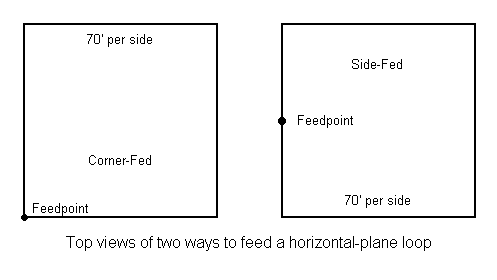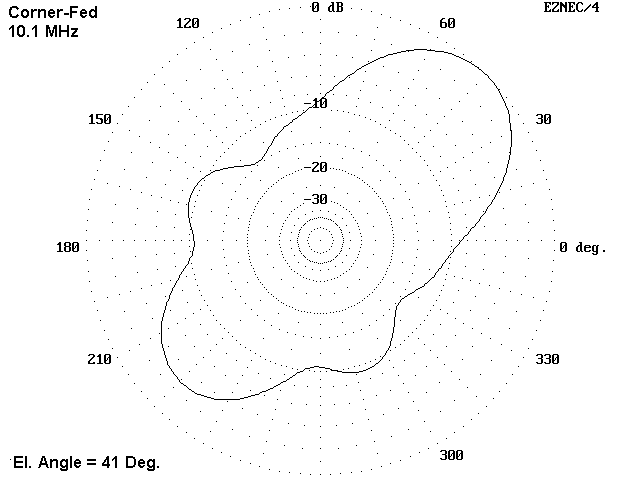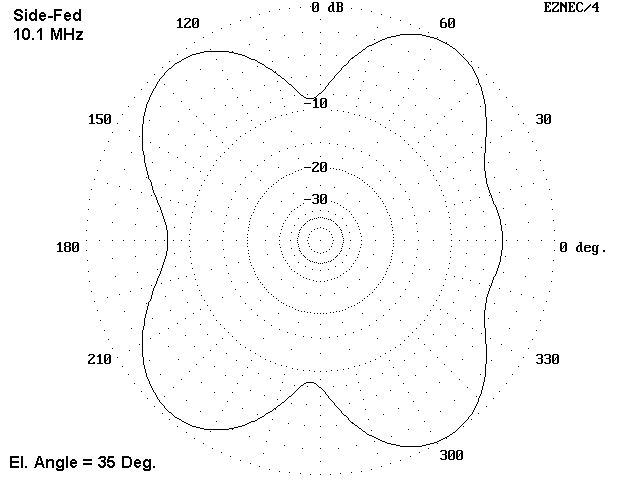 Notes on All-Band Use of Horizontal-Plane
Loops
Notes on All-Band Use of Horizontal-Plane
Loops

The general summary is this: on 80, either loop is a cloud burner, but with pretty good gain at 45 degrees elevation. In general, except for 40 meters, the corner-fed loop shows more bi-directional patterns (with minor side lobes), mostly through the corners where the feedpoint is the backside. On bands from 20 meters, there is up a slight (3-4 dB) front-to-back ratio.
Fed on one side (rather than at a corner), there is a tendency for the antenna to exhibit more lobes per band, with those to the far side from the feedpoint being slightly stronger--again by no more than 2-4 dB.
Both the corner-fed and the side-fed antennas, as the charts will show, represent easy work on an antenna tuner, with very reasonable values of R and X. Indeed, a 300- ohm line will likely show the smallest excursions of R and X along the line length, although 450-ohm line is perfectly good as well. From the values in the chart, line length should not be critical.
In the charts below, all maximum gain figures use the TO angle (elevation angle of maximum radiation) except for 80 meters, whether the gain is at a 45-degree TO angle.
1 wl loop (70'/side), corner-fed: #12 copper 35' up over medium earth: Freq. TO angle Max Gain Feed Z Pattern notes MHz degrees dBi R+/-jX 3.58 90 5.16@45 67 +j 4 oval thru corners 7.1 48 5.69 84 -j150 oval across corners 10.1 41 9.32 370 -j575 narrow oval thru corners 14.1 27 10.51 305 -j105 clover leaves thru corners 18.1 20 13.75 350 +j240 EDZ-like thru corners 21.1 17 13.63 245 -j105 clover 24.95 14 14.09 320 +j110 thru crnrs w/side lobes 28.1 12 12.92 225 -j145 12 lobes 1 wl loop (70'/side, side-fed:) #12 copper 35' up over medium earth: Freq. TO angle Max Gain Feed Z Pattern notes MHz degrees dBi R+/-jX 3.58 90 5.09@45 65 +j 4 oval thru sides 7.1 44 6.73 275 +j130 oval thru sides 10.1 35 6.86 285 -j535 lobes at corners 14.1 27 9.69 265 -j165 4 lobes at corners 18.1 21 11.65 400 +j180 6 lobes, strong=far side 21.1 18 10.61 400 -j120 many lobes, strng=far side 24.95 15 11.08 370 +j 45 many lobes, strng=far side 28.1 11 11.83 250 -j180 many lobes, strng=far side
The side-fed shows slightly less max gain on the upper bands, but has more stronger lobes other than the corner-fed version. If the pattern notes can be deciphered, you can choose whichever suits your operating desires most.
To assiset in interpreting the brief pattern notes, the following azimuth patterns of corner-fed and side-fed HP loops at 10.1, 21.1, and 28.1 MHz may be useful. For each pattern, the antena is a square aligned with the graphic borders. The corner-fed model is fed at the lower left corner of the graphic. The side-fed model is fed at the middle of the left side.


The 10.1 MHz patterns show the most unique differences, with the corner-fed model having a beam-like pattern, while the side-fed model pattern is somewhat non-descript but more omnidirectional.


At 21.1 MHz, the side-fed model shows much broader lobes, while the energy from the corner-fed model is concentrated in 4 fairly narrow lobes.


By the 10 meter band, there is little to choose from between the two antennas.
As a general rule, the horizontal loop offers more directions, especially in the side-fed version, than the single wire, which concentrates its energy more toward the ends as the frequency goes up. A compendium of patterns for 135' doublets and for 102' doublets appears in notes taken from the series done for Low Down. The loop has fewer bands with problematical impedances than any of the doublets.
For all-band use, the HP loop seems to offer more than the VP loop.
The HP loop elevation angles are close to those of a single wire
doublet, which places them lower and stronger than those for a VP loop. In general, with either mode of feeding, expect strongest
results in the quadrants across the way from the feedpoint.
Updated 10-28-97. © L. B. Cebik, W4RNL. Data may be used for
personal purposes, but may not be reproduced for publication in print or
any other medium without permission of the author.